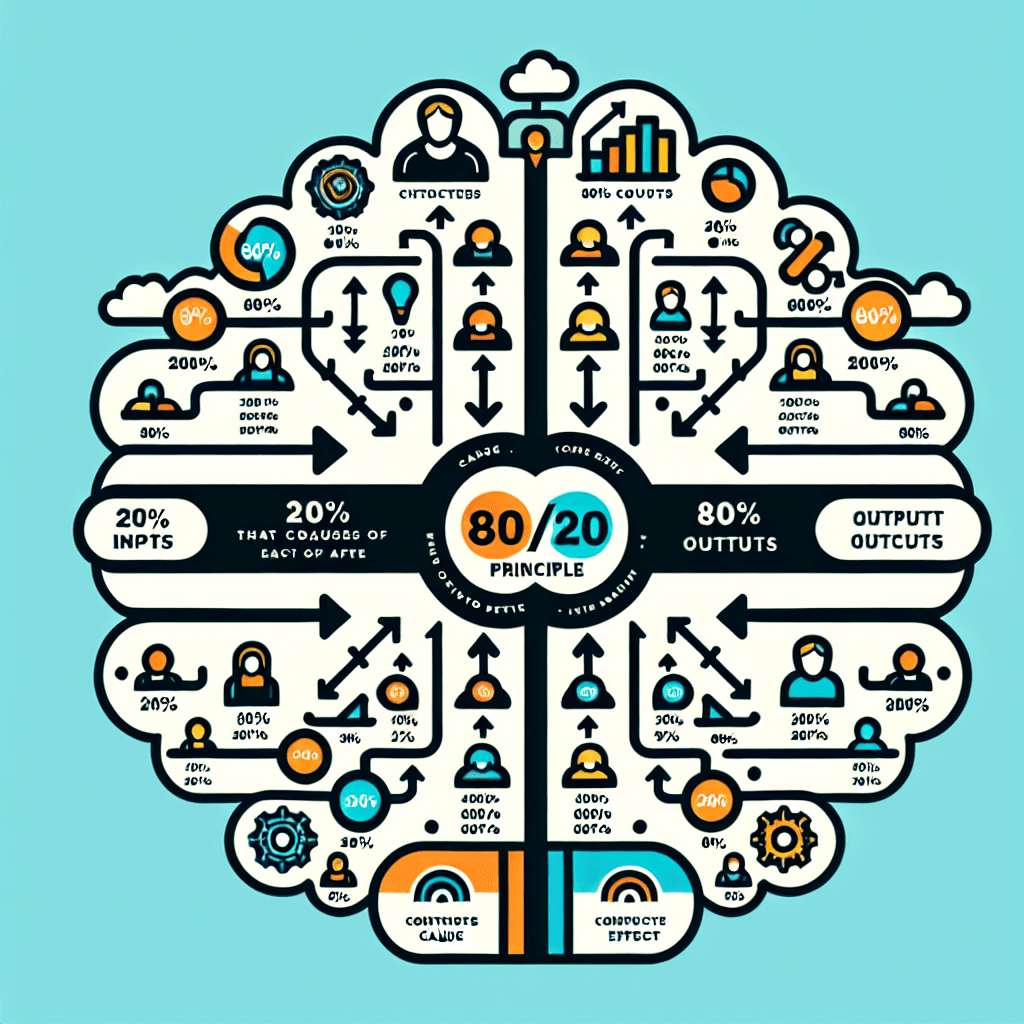Table of Contents
Unlocking greater efficiency in your personal and professional life can often feel like a daunting task. Yet, the key to transforming your approach may lie in the simplicity of the 80/20 Rule.
By focusing on the 20% of activities that yield 80% of your desired outcomes, you can maximize impact and streamline productivity.

This principle, known as the Pareto Principle, offers a lens through which you can identify which tasks, strategies, or relationships hold the greatest value.
Leveraging this rule allows you to prioritize effectively and make informed decisions that enhance results.
Using the 80/20 Rule, you can apply a strategic approach to both group dynamics and personal growth, leading to enhanced performance and satisfaction.
Exploring how the 80/20 Rule can be integrated into evolving technologies and team environments can open up a world of opportunities.
This approach facilitates clear communication and heightened return on investment by concentrating efforts where they matter most.
Dive into the following insights to discover how this guiding principle can reshape your decision-making and productivity practices.
Key Takeaways
- Focus on high-impact activities to maximize efficiency.
- Prioritize tasks that drive significant results.
- Integrate the 80/20 Rule into team and personal development.
Understanding the 80/20 Rule

The 80/20 Rule, also known as the Pareto Principle, highlights that a significant portion of results or effects, usually about 80%, stem from a small percentage of causes or efforts, typically around 20%.
By focusing on these critical factors, you can achieve maximum impact with minimal resources.
Historical Context and Definition
The Pareto Principle originates from the work of Italian economist Vilfredo Pareto in the late 19th century. He observed that 80% of the land in Italy was owned by 20% of the population. This observation of an uneven distribution can be seen in various aspects of life and work.
In essence, the 80/20 rule suggests that by identifying and centering on the vital few causes, you can optimize performance while minimizing effort.
This rule is often applied to enhance productivity, profits, and other outcomes by focusing on the most consequential factors.
Identifying the Vital Few
To effectively apply the 80/20 Rule, focus efforts on identifying which factors contribute the most. This involves differentiating the vital few from the trivial many.
Start by analyzing data and identifying the top 20% of actions or resources that responsible for 80% of the desired results.
This prioritization allows you to direct your resources efficiently and concentrate on what truly matters.
Tools such as data analysis and feedback mechanisms can aid in pinpointing these critical activities, facilitating impactful strategies and decisions.
Applying the 80/20 Rule to Productivity

Boosting productivity involves focusing on the tasks that yield the most significant results. By utilizing the 80/20 rule, you can identify where to direct your efforts to achieve maximum impact.
Prioritization Techniques
To implement the 80/20 rule effectively, start by listing all tasks. Then, identify the top 20% most impactful tasks using criteria like urgency, relevance to goals, and potential outcomes.
Make a list of priorities, and check them regularly to adjust as needed.
When you examine tasks critically, you maximize time spent on what truly drives success.
Use digital tools like task managers to organize and keep track of tasks. Remember that not all tasks are equal—some provide more value than others.
Managing Tasks and Time
Time management is essential for applying the 80/20 rule. Allocate the majority of your time to high-impact tasks that fit within your top 20%.
You can enhance productivity by designating specific time blocks for these activities.
Use tools like a calendar to allocate periods for focused work without interruptions.
Setting clear deadlines helps prevent less important tasks from consuming your valuable time.
Regularly reassess how you spend your time to ensure alignment with your priorities.
By deliberately choosing where to allocate effort, you make strides toward achieving your goals more efficiently.
Decision-Making Strategies

Applying the 80/20 Rule can greatly enhance decision-making. By focusing on the most impactful choices and assessing risks accurately, you can optimize your results.
Leveraging the Rule for Better Choices
The 80/20 Rule encourages you to identify the few activities that significantly impact your objectives. By prioritizing these tasks, you can make decisions that maximize effectiveness.
For example, in a business context, identify the 20% of clients or products that account for 80% of revenue.
Focusing on these areas allows you to allocate resources more intelligently.
Use this principle to fine-tune your strategies and clarify goals, reducing unnecessary efforts on less influential factors.
Consistent evaluation ensures resources are aligned with high-impact areas.
Risk Assessment and Mitigation
Effectively applying the 80/20 Rule involves recognizing risks within the critical 20% of your actions. By identifying potential pitfalls early, you can mitigate negative impacts.
Consider creating a risk matrix to assess and rate risks according to their likelihood and potential impact.
This systematic approach allows for better preparedness and strategic response.
Additionally, developing contingency plans for high-risk areas ensures resilience.
Implement best practices by diligently monitoring key indicators and adapting strategies as needed.
Proactively addressing these risks supports more confident and informed decision-making, enhancing your capabilities.
Effective Communication Through the 80/20 Lens

Utilizing the 80/20 rule in communication helps you identify and prioritize the most impactful messages and vital listening cues, allowing for more meaningful exchanges. By doing so, you can boost understanding and cooperation.
Conveying Core Messages
Identify key ideas that drive your communication goals. Determine which 20% of messages contribute to 80% of the impact.
This approach encourages clarity and precision, ensuring that important points do not get lost in unnecessary details.
Focus on the most relevant information. Utilize bullet points or concise summaries for emphasis.
When communicating, highlight these essential messages early in the conversation to capture attention and start meaningful dialogues. Visual aids, like charts, can reinforce understanding.
Listening for the Vital Few
Effective listening involves recognizing valuable points made by others. Pay attention to the primary themes and ideas that are crucial to understanding the conversation’s context.
Listen actively to identify the 20% of information that offers the most insight or solution paths.
Take brief notes to track main ideas and responses.
By honing in on these critical elements, you’ll become more responsive and attentive. This method enhances your ability to engage in dialogue that is both constructive and fulfilling.
Employing active listening techniques, such as nodding or summarizing back, can further improve understanding.
Return on Investment with the 80/20 Rule

Understanding the Pareto Principle can enhance your decision-making process in achieving a significant return on investment. By identifying high-impact activities, you can allocate resources efficiently for optimal results.
Evaluating Effort vs. Outcome
Applying the 80/20 rule, you’ll find that 80% of your results often stem from 20% of your efforts. This principle helps you align your focus on actions that yield the most substantial return on investment.
Start by analyzing your past projects to identify what actions have consistently led to high returns.
Quantify these results with metrics such as percentage increases in revenue or time spent versus value delivered.
This analysis allows you to eliminate low-impact activities, thereby improving your efficiency in time and resource management.
Data-driven insights play a crucial role in evaluating these outcomes, enabling better prioritization in future endeavors.
Resource Allocation for Maximum Impact
To capitalize on the 80/20 rule, allocate resources to the tasks identified as the most impactful.
For instance, if certain marketing strategies are disproportionately successful, focus your budget and team efforts on enhancing these channels.
Regular performance assessments can provide timely feedback on how well resources are being utilized, ensuring adjustments can be made swiftly.
This allocation isn’t merely about cutting costs but optimizing how resources such as time, personnel, and budgets are used.
By concentrating on high-impact areas, you improve not only financial returns but also employee satisfaction and productivity. Prioritization becomes a strategic tool, aiding in sustainable growth and competitive advantage.
Incorporating the 80/20 Rule into Team Dynamics
Applying the 80/20 rule in team dynamics can significantly enhance productivity and efficiency. By identifying and focusing on the key factors and behaviors that drive the majority of outcomes, teams can improve performance and streamline communication processes.
Building High-Performing Teams
To build high-performing teams, start by recognizing the top 20% of team members whose efforts create 80% of the results.
Emphasize mentorship and skill development for these key players to amplify their impact.
Encourage these individuals to take on leadership roles, driving important projects to success.
Communication forms the backbone of efficient teams. Facilitate open channels for sharing insights and feedback.
Regular check-ins allow team members to align objectives and address potential bottlenecks swiftly, maintaining momentum and focus.
Prioritize collaboration tools to enhance productivity, ensuring the right information is accessible when needed.
Fostering a Culture of Efficiency
Creating a culture of efficiency involves focusing on the activities and processes that yield the highest returns.
Begin by auditing team workflows to identify inefficiencies and redundant tasks.
Deploy the 80/20 rule to determine which practices generate the most success.
Incentivize teams to develop proactive habits that contribute to faster, more effective outcomes.
Encourage team members to prioritize tasks by urgency and importance, minimizing efforts spent on low-impact activities.
Use data and metrics to regularly evaluate the team’s performance and adjust strategies accordingly, ensuring sustained productivity and efficiency.
This strategic focus supports not only immediate outcomes but long-term growth and achievement.
Implementing 80/20 Best Practices in Personal Development
Incorporating the 80/20 rule into personal development involves identifying parts of your life where focused effort yields the most results. By applying this principle, you enhance productivity and intelligence while fostering continuous growth.
Continuous Learning and Growth
The 80/20 rule can be applied to identify the most beneficial learning activities.
Focus on resources that provide the greatest knowledge impact. For instance, prioritize books, courses, or mentors that offer invaluable insights.
Develop a list of subjects and skills that are pivotal to your goals.
Through targeted learning, you cultivate an intelligence that powers personal and professional growth.
Evaluate your progress periodically to ensure the resources remain relevant.
Opt for methods such as online learning platforms or podcasts, which often deliver concentrated and high-value content. Consider setting specific learning objectives to stay motivated.
Self-Assessment Using the 80/20 Rule
Self-assessment is crucial for implementing the 80/20 rule effectively. Begin by examining your activities to pinpoint where your energy leads to the most productivity.
This could mean spending more time on tasks that directly contribute to personal goals, such as exercise for well-being or focused work sessions for career advancement.
Create a chart to visualize where your efforts align with your outcomes. Eliminate or reduce activities that consume more energy than they provide in results.
By streamlining your focus, you sharpen your intelligence and direct it towards impactful areas. Regular self-assessment helps you adapt the rule as your life priorities change, fostering long-term improvement and efficiency.
Adapting the 80/20 Rule to Evolving Technologies
Evolving technologies offer new ways to apply the 80/20 rule, enhancing efficiency and leveraging predictive analytics for better decision-making. Understanding these advancements helps you maximize productivity and impact.
Innovations in Efficiency
Embrace technologies like automation and artificial intelligence (AI) as they play critical roles in optimizing the application of the 80/20 rule. AI-driven tools can identify the critical 20% of tasks that drive 80% of results, streamlining operations.
With automation, repetitive tasks are minimized, allowing you to focus on strategic activities. This technological evolution ensures that efforts are concentrated on areas that offer maximum value, reducing time wasted on less impactful tasks.
Incorporating AI and automation into your workflow not only enhances efficiency but also ensures resources are allocated effectively.
Predictive Analytics and the 80/20 Rule
Predictive analytics further amplifies the power of the 80/20 rule by forecasting outcomes based on data patterns. Using machine learning algorithms, businesses can predict which activities will yield substantial returns.
By analyzing historical data, you gain insights into trends, allowing for more informed priority-setting. This data-driven approach helps in predicting market movements and customer behaviors, aligning your focus on high-impact efforts.
Predictive tools thus support strategic decision-making, effectively applying the 80/20 principle to stay ahead in rapidly changing technological landscapes.
Frequently Asked Questions
Explore how the 80/20 rule can optimize productivity, time management, business operations, relationships, and health plans. Familiarize yourself with common misconceptions, ensuring you apply the principle effectively.
How can the 80/20 rule be applied to enhance productivity?
Focusing on tasks that yield the most significant results can boost your productivity. By identifying the top 20% of activities that produce 80% of your outcomes, you can prioritize these tasks to achieve maximum efficiency.
What are some practical examples of the Pareto Principle in time management?
In time management, the Pareto Principle illustrates that a few key tasks can drive most of your progress.
For instance, concentrating on a handful of high-priority projects can help you accomplish more than attempting to tackle numerous minor tasks.
In what ways does the 80/20 rule impact business operations and decision-making?
In business, the 80/20 rule aids in identifying key areas that generate the most value.
Companies often discover that a small portion of products or clients account for the majority of profits, enabling them to allocate resources more strategically.
How can one use the 80/20 rule to improve personal or professional relationships?
Applying the 80/20 rule to relationships involves focusing on the most meaningful aspects.
By dedicating time and energy to the 20% of interactions that strengthen bonds, you can cultivate both personal and professional relationships more effectively.
Could you explain the implementation of the 80/20 rule in diet and health plans?
In health, identifying the small percentage of foods or habits that lead to the majority of health benefits is crucial.
By emphasizing those beneficial elements, you can streamline your diet and exercise routines for more substantial results.
What are the common misconceptions about the application of the 80/20 rule?
One misconception is that it applies universally, whereas some scenarios might not fit this model.
Additionally, some believe the rule guarantees success without recognizing the need for diligent analysis and adaptation to specific contexts.
Ready to apply the 80/20 Rule for optimal results?
Explore these resources:
- “The 80/20 Principle: The Secret to Achieving More with Less” by Richard Koch: This is the definitive book on the Pareto Principle and its widespread applications.
- “Essentialism: The Disciplined Pursuit of Less” by Greg McKeown: While not solely about 80/20, its core message of focusing on the vital few aligns perfectly.
- “The One Thing: The Surprisingly Simple Truth Behind Extraordinary Results” by Gary Keller and Jay Papasan: Emphasizes finding the “one thing” that, by doing it, makes everything else easier or unnecessary – a direct application of the 80/20 rule.
- “Deep Work: Rules for Focused Success in a Distracted World” by Cal Newport: Encourages focusing on high-impact, cognitively demanding tasks, which often fall into the 20%.
- “Getting Things Done (GTD)” by David Allen: Offers a system for managing tasks and projects that, when applied with the 80/20 mindset, can lead to greater efficiency.




